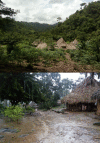Effect of Geographic Isolation on the Nasal Virome of Indigenous Children
- PMID: 31189707
- PMCID: PMC6694818
- DOI: 10.1128/JVI.00681-19
Effect of Geographic Isolation on the Nasal Virome of Indigenous Children
Abstract
The influence of living in small remote villages on the diversity of viruses in the nasal mucosa was investigated in three Colombian villages with very different levels of geographic isolation. Metagenomic analysis was used to characterize viral nucleic acids in nasal swabs from 63 apparently healthy young children. Sequences from human virus members of the families Anelloviridae, Papillomaviridae, Picornaviridae, Herpesviridae, Polyomaviridae, Adenoviridae, and Paramyxoviridae were detected in decreasing proportions of children. The number of papillomavirus infections detected was greater among Hispanic children most exposed to outside contacts, while anellovirus infections were more common in the isolated indigenous villages. The diversity of the other human viruses detected did not differ among the villages. Closely related variants of rhinovirus A or B were identified in 2 to 4 children from each village, reflecting ongoing transmission clusters. Genomes of viruses not currently known to infect humans, including members of the families Parvoviridae, Partitiviridae, Dicistroviridae, and Iflaviridae and circular Rep-encoding single-stranded DNA (CRESS-DNA) virus, were also detected in nasal swabs, possibly reflecting environmental contamination from insect, fungal, or unknown sources. Despite the high levels of geographic and cultural isolation, the overall diversity of human viruses in the nasal passages of children was not reduced in highly isolated indigenous villages, indicating ongoing exposure to globally circulating viruses.IMPORTANCE Extreme geographic and cultural isolation can still be found in some indigenous South American villages. Such isolation may be expected to limit the introduction of otherwise common and widely distributed viruses. Very small population sizes may also result in rapid local viral extinction due to a lack of seronegative subjects to maintain transmission chains for rapidly cleared viruses. We compared the viruses in the nasal passages of young children in three villages with increasing levels of geographic isolation. We found that isolation did not reduce the overall diversity of viral infections. Multiple infections with nearly identical rhinoviruses could be detected within each village, likely reflecting recent viral introductions and transmission clusters among epidemiologically linked members of these very small communities. We conclude that, despite their geographic isolation, remote indigenous villages show evidence of ongoing exposure to globally circulating viruses.
Keywords: Colombia; children; metagenomics; nasal virome; next-generation sequencing; papillomavirus; rhinovirus.
Copyright © 2019 American Society for Microbiology.
Figures







